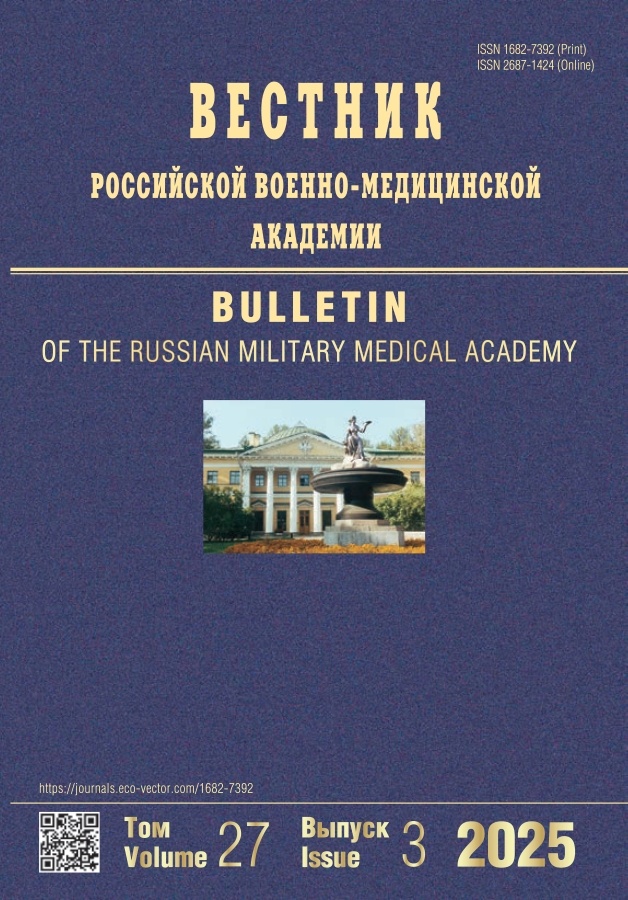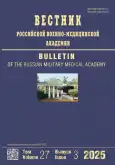Клинико-анатомические особенности взрывных поражений с ведущим повреждением органов живота
- Авторы: Сазонов А.А.1, Ромащенко П.Н.1, Майстренко Н.А.1, Фомин Н.Ф.1, Макаров И.А.1, Алиев Р.К.1
-
Учреждения:
- Военно-медицинская академия им. С.М. Кирова
- Выпуск: Том 27, № 3 (2025)
- Страницы: 301-312
- Раздел: Оригинальное исследование
- URL: https://bakhtiniada.ru/1682-7392/article/view/319561
- DOI: https://doi.org/10.17816/brmma660870
- EDN: https://elibrary.ru/HLGERC
- ID: 319561
Цитировать
Аннотация
Обоснование. Важная особенность современных боевых действий — широкое использование в качестве носителей взрывных устройств беспилотных летательных аппаратов, обеспечивающих их адресную доставку и срабатывание на разном уровне относительно осевого скелета человека. Это, несомненно, повлияло на анатомо-топографическую структуру взрывных повреждений. Она стала более разнообразной по сравнению с предшествующими вооруженными конфликтами, где преобладала классическая (контактная) минная травма с разрушением нижних конечностей. Исходя из этого, изучение особенностей воздействия поражающих факторов взрыва на организм пострадавших с ведущим повреждением живота весьма актуально.
Цель — определить частоту взрывных поражений с ведущим повреждением органов живота и проанализировать их клинико-анатомические особенности с учетом экспериментальных данных о механогенезе данного вида боевой травмы.
Методы. Изучены клинико-анатомические особенности повреждений у раненых с взрывным поражением живота. Проведен сравнительный анализ течения травматической болезни и результатов хирургического лечения двух групп пациентов. В основную группу включены 52 раненых с взрывным поражением, контрольную группу составили 65 пациентов с осколочными ранениями. Исследуемые группы пациентов были сопоставимы по тяжести повреждений и исходному состоянию, при этом ведущей локализацией повреждений во всех случаях был живот.
Результаты. Клинико-анатомические признаки воздействия первичных факторов взрыва выявлены у 10,3% пациентов с осколочными ранениями живота. Повреждения в результате бризантного и ударно-волнового механизма отмечены у 46 и 100% соответственно раненых основной группы. Общая частота осложнений составила 48,1% в основной группе и 38,5% — в контрольной (р >0,05), при этом выявлена тенденция к статистически значимым (р=0,07) различиям в отношении осложнений III–IV степени по Clavien–Dindo.
Заключение. Первичные факторы взрывной травмы оказывают существенное негативное влияние на течение травматической болезни при взрывном поражении живота, что проявляется увеличением частоты инфекционных осложнений со стороны легких и мягких тканей конечностей, а также тенденцией к более частому развитию перфораций кишечного тракта вследствие несостоятельности межкишечных анастомозов и острых язв.
Полный текст
Открыть статью на сайте журналаОб авторах
Алексей Андреевич Сазонов
Военно-медицинская академия им. С.М. Кирова
Email: vmeda-nio@mil.ru
ORCID iD: 0000-0003-4726-7557
SPIN-код: 4042-7710
д-р мед. наук, доцент
Россия, Санкт-ПетербургПавел Николаевич Ромащенко
Военно-медицинская академия им. С.М. Кирова
Email: vmeda-nio@mil.ru
ORCID iD: 0000-0001-8918-1730
SPIN-код: 3850-1792
д-р мед. наук, профессор
Россия, Санкт-ПетербургНиколай Анатольевич Майстренко
Военно-медицинская академия им. С.М. Кирова
Email: vmeda-nio@mil.ru
ORCID iD: 0000-0002-1405-7660
SPIN-код: 2571-9603
д-р мед. наук, профессор
Россия, Санкт-ПетербургНиколай Федорович Фомин
Военно-медицинская академия им. С.М. Кирова
Email: fominmed@mail.ru
ORCID iD: 0000-0001-8474-5621
SPIN-код: 7713-2412
д-р мед. наук, профессор
Россия, Санкт-ПетербургИван Александрович Макаров
Военно-медицинская академия им. С.М. Кирова
Автор, ответственный за переписку.
Email: vmeda-nio@mil.ru
ORCID iD: 0000-0002-4118-5553
SPIN-код: 7280-7007
адъюнкт
Россия, 194044, Санкт-Петербург, ул. Академика Лебедева, д. 6ЖРустам Камильевич Алиев
Военно-медицинская академия им. С.М. Кирова
Email: vmeda-nio@mil.ru
ORCID iD: 0000-0002-0566-5066
SPIN-код: 9854-9010
адъюнкт
Россия, Санкт-ПетербургСписок литературы
- Polushin YuS. Blast injuries (lecture). Messenger of Anesthesiology and Resuscitation. 2022;19(6):6–18. doi: 10.21292/2078-5658-2022-19-6-6-17 EDN: IEYZCF
- Fomin NF. Contribution of scientists of the Military Medical Academy to the study of mechanogenesis of mine-explosive trauma. Saint Petersburg: VMedA; 2021. 52 p. (In Russ.)
- Ovchinnikov DV, Ivchenko EV. Military medicine of modern hybrid wars. Izvestia of the Russian Military Medical Academy. 2024;43(3):331–340. doi: 10.17816/rmmar633158 EDN: EHVYUH
- Bozhchenko AP, Boldaryan AA, Kapustin EV, et al. Structure of fatal injuries in a modern armed conflict. Military Medical Journal. 2024; 345(10):21–28. doi: 10.52424/00269050_2024_345_10_21 EDN: ROWOJP
- Wani I, Fazal Q, Parray T. Spectrum of abdominal organ injury in a primary blast type. World J Emerg Surg. 2009;(1):1–5. doi: 10.1186/1749-7922-4-46 EDN: YNIVLG
- Ritenour AE, Baskin TW. Primary blast injury: update on diagnosis and treatment. Crit Care Med. 2008;36(7 Suppl):S311–S317. doi: 10.1097/CCM.0b013e31817e2a8c
- Minnullin IP, Taranov II, Magamadov AKH. Abdominal injuries in explosions. Saint Petersburg: SpetsLit; 2022. 191 p. (In Russ.) ISBN: 978-5-299-01150-0
- Wolf SJ, Bebarta VS, Bonnett CJ, et al. Blast injuries. Lancet. 2009;374(9687):405–415. doi: 10.1016/S0140-6736(09)60257-9
- Nechaev EA, Gritsanov AI, Minnullin IP, et al. Blast injuries. Saint Petersburg: Foliant; 2002. 656 p. (In Russ.) ISBN: 978-5-86581-077-4
- Trukhan AP. Features of treatment of peritonitis in patients with gunshot and explosive wounds of the abdomen in peacetime. Surgery. East Europe. 2024;13(2):223–229. doi: 10.34883/PI.2024.13.2.034 EDN: WXOMZC
- Kovalov GA, Chizh NA, Volina VV, et al. Morphological investigation of tissues following experimental mine-blast trauma. Morphologia. 2019;13(2):45–53. doi: 10.26641/1997-9665.2019.2.45-53 EDN: KKRVWL
- Denisov AV, Anisin AV, Bozhchenko AP, et al. Damage factors of explosive munitions. Bulletin of the Russian Military Medical Academy. 2017;(4):180–185. EDN: YLNRUK
- Grzhibovski AM, Ivanov SV, Gorbatova MA. Propensity score matching as a modern statistical method for bias control in observational studies with binary outcome. Human Ecology. 2016;(5):50–64. doi: 10.33396/1728-0869-2016-5-50-64 EDN: VWSEQX
- Sazonov AA, Romashchenko PN, Makarov IA, et al. Differentiated approach for using vacuum-assisted laparostomy in gunshot abdominal wounds. Grekov's Bulletin of Surgery. 2023;182(6):11–18. doi: 10.24884/0042-4625-2023-182-6-11-18 EDN: ZSCUZX
- Dindo D, Demartines N, Clavien PA. Classification of surgical complications: a new proposal with evaluation in a cohort of 6336 patients and results of a survey. Ann Surg. 2004;240(2):205–213. doi: 10.1097/01.sla.0000133083.54934.ae
Дополнительные файлы
















